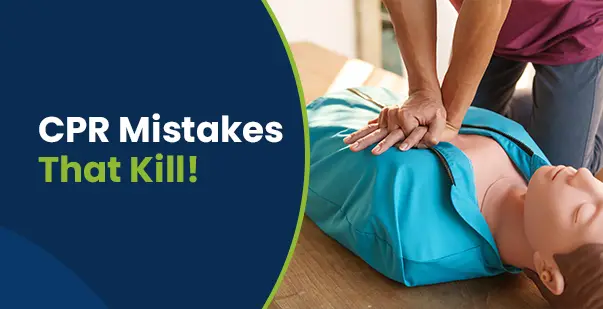Every second matters in the critical moments following a sudden cardiac arrest (SCA). Imagine being in a supermarket, and the person next to you passes out. Now that their lives are on the line, what you do in the next few minutes could decide whether they live to see tomorrow.
The key step of emergency response is chest compressions, a simple but effective procedure that can bridge the gap between someone’s life and death. When performed efficiently, these steady chest pushes physically pump blood to the brain and other critical organs, buying valuable time until medical help arrives on the scene. So, learn the importance of chest compressions during the ‘Golden Hour’, the techniques you should follow, common mistakes to avoid, and more.
Master ACLS Now
Get ACLS certified with confidence
Why Chest Compressions Are the First Line Response
Chest compressions provide artificial circulation with the help of which oxygen reaches the brain and other internal organs until advanced medical help is given to the victim. Below are the key reasons why these compressions are the first and most essential action in saving a life:
Maintain Blood Flow When the Heart Stops
When the heart stops beating, blood flow to the brain and other vital organs halts, leading to oxygen deprivation. Moreover, irreversible brain damage can occur within the first 10 minutes without the proper oxygen supply. If CPR is not initiated immediately, conditions like global cerebral ischemia can occur. This can result in cognitive deficits, loss of motor function, and other severe neurological impairments.
CPR compressions act like a manual pump, pushing blood through the body and buying precious time until medical help arrives or a defibrillator is used.
Use Critical First Minutes Effectively After Cardiac Arrest
The first 4-6 minutes after cardiac arrest determine survival chances. For every minute without CPR, survival drops 7-10%. Therefore, someone must start chest compressions immediately without waiting for emergency services. Early action improves recovery odds and can even double or triple the survival rates.
Quick and Easy to Start
Chest compressions don’t require any special equipment, which makes them the fastest possible response in an emergency. Once you recognize that someone is unresponsive and not breathing normally, you can start compressions right away. There’s no need to wait; you can begin helping the person within seconds.
Utilize Reserved Oxygen
Even after breathing stops, the blood contains usable oxygen for several minutes. Chest compressions help distribute this residual oxygen to the brain and heart, which remain the top priorities during the initial response to cardiac arrest. That’s why continuous compressions, even without rescue breaths in the first few minutes, are effective in supporting survival until more definitive care is available.
How to Perform Chest Compressions?
Performing chest compressions efficiently requires specific body positioning, applying the correct force, and paying attention to technique. The right approach maximizes blood flow while minimizing the risk of injury to the person in need. Below are the key considerations for effective compressions:
Body Positioning for Maximum Effectiveness
Position yourself directly over the victim’s chest. Kneel close to their side and keep your shoulders directly above your hands. Lock your elbows straight. Use your body weight, not just arm strength. This positioning helps deliver high-quality chest compressions and reduces rescuer fatigue. Proper positioning makes compressions more effective.
Surface Considerations for Compression Quality
Perform chest compressions on a firm surface. Soft surfaces like beds absorb compression force. Move victims from soft to hard surfaces when possible. If moving isn’t possible, place a backboard under them. Firm surfaces ensure compression force pumps the heart effectively.
The Recoil Factor in Compression Cycles
Complete chest recoil between compressions is crucial. Allow the chest to return to its normal position fully. This creates negative pressure that draws blood back into the heart. If the rescuer leans on the chest, it prevents full recoil and reduces blood flow. Full recoil maximizes the role of chest compressions in cardiac arrest. It optimizes both the heart’s ability to refill and the amount of blood pushed out with the next compression.
Minimizing Interruptions in Compression Cycles
Keep interruptions in chest compressions minimal. Every pause means blood stops flowing. Thus, limit any break to no more than 10 seconds, including during airway management or rhythm checks. To prevent fatigue, rescuers should switch roles every 2 minutes. Coordinate pulse checks and breaths during these switches to avoid additional delays.
Depth, Rate, and Hand Placement Guidelines
Following specific guidelines for compression depth, rate, and hand placement ensures maximum effectiveness. These technical aspects of CPR have been refined through research to optimize blood flow during cardiac emergencies.
Optimal Compression Depth
Push hard to a depth of at least 2 inches (5 cm) in adults. Don’t exceed 2.4 inches (6 cm). Children need compressions about one-third of chest depth. However, infants need 1.5 inches (4 cm). Inadequate depth fails to create blood flow, and too deep risks internal injuries. Proper depth and rate of chest compressions directly impact survival chances.
Target Compression Rate
Maintain a rate of 100-120 compressions per minute. This pace optimizes blood circulation. Too slow doesn’t generate enough flow. Too fast doesn’t allow proper heart filling between compressions. A helpful tip is to compress to the beat of songs like “Staying Alive” or “Another One Bites the Dust,” which have approximately 100-120 beats per minute.
Correct Hand Placement
Place the heel of one hand on the lower half of the sternum (breastbone) at the center of the chest. Then, place your other hand on top and either interlace your fingers or keep them raised so they don’t touch the chest. Be careful to avoid the very bottom of the sternum, known as the xiphoid process, as pressing here can cause injury. Proper hand placement during CPR chest compression technique prevents rib and internal organ damage.
Special Considerations for Different Age Groups
When performing CPR, techniques must be adjusted based on the victim’s age to ensure both effectiveness and safety. For adults, use two hands placed on the center of the chest, delivering compressions at a depth of at least 2 inches (5 cm) at a rate of 100–120 compressions per minute. For children, use one or two hands, depending on the child’s size, with a recommended depth of about 2 inches (5 cm).
For infants, use two fingers (or the thumb-encircling technique if two rescuers are present) in the center of the chest, just below the nipple line. Compressions should be about 1.5 inches (4 cm) deep and administered at a rate of 100–120 per minute.
Read more: Difference Between An Adult, Infant And A Child CPR
Hands-Only CPR: When and How to Use It?
For bystanders without medical training, hands-only CPR provides a simpler alternative that focuses exclusively on chest compressions. It also removes barriers to action in emergencies.
When to Use Hands-Only CPR?
Hands-only CPR is recommended for teens and adults who suddenly collapse and are unresponsive. It’s most effective in the first few minutes after cardiac arrest when oxygen is still present in the blood. This method is ideal for bystanders who are untrained, uncomfortable with mouth-to-mouth, or worried about disease transmission, such as during a pandemic.
However, it’s not recommended for:
- Children or infants
- Drowning victims
- Drug overdoses
- Cases involving breathing problems
These situations typically involve oxygen deprivation and, therefore, require traditional CPR with rescue breaths.
How Does Hands-Only CPR Actually Work?
Hands-only CPR works because blood already contains some oxygen when a person collapses. Chest compressions manually pump the heart, pushing that oxygen-rich blood to the brain and vital organs. Studies show similar survival rates between traditional and hands-on CPR for the first few minutes. This simplified approach encourages more bystanders to act. More response means more lives saved.
What Are the Steps for Performing Hands-Only CPR?
First, check if the person is responsive. If not, call 911 immediately. Begin chest compressions right away. Push hard and fast in the center of the chest and keep a steady rhythm. Continue until professional help arrives. Don’t stop to check for pulse or breathing. Immediate, uninterrupted action offers the best chance of survival
Why Are Some Bystanders Still Hesitant to Act?.
One of the biggest barriers to CPR is fear of doing it wrong, of hurting the person, or of contracting an infection. Hands-only CPR helps eliminate those fears by removing mouth-to-mouth contact. It’s simple, safer, and even dispatcher-guided CPR over the phone can help you through it in real-time.
The key message: any CPR is better than none. Taking quick action, even if it’s not perfect, dramatically increases survival chances.
Read more: What Is The Indication For Mouth-To-Mouth Rescue Breaths?
Common Mistakes and How to Avoid Them
Studies show that over 60% of lay rescuers perform chest compressions at an incorrect depth or rate, potentially reducing CPR effectiveness (Resuscitation, 2017). Even well-trained rescuers make errors during CPR that reduce effectiveness. Thus, understanding these common mistakes helps deliver high-quality chest compressions consistently during emergencies.
Insufficient Compression Depth
Many rescuers don’t press deeply enough, often out of fear of causing injury or simply due to fatigue. However, effective CPR requires compressions at least 2 inches (5 cm) deep in adults. Cardiac arrest is already life-threatening. Moreover, the benefit of deep compressions outweighs the injury risk. Thus, Push hard, push deep, and allow the chest to recoil between compressions fully.
Excessive Interruptions
Each pause in compressions stops blood flow to vital organs completely. Many rescuers stop too often to check for a pulse or signs of breathing. These checks should be brief and only during necessary transitions, such as switching compressors. Keep all interruptions under 10 seconds. This is because continuous compressions matter more than perfect rhythm to keep the blood moving.
Improper Hand Position
Hands placed too low can damage the xiphoid process of the sternum, while misaligned hands won’t compress the heart properly. The CPR chest compression technique requires centered hand placement on the lower half of the sternum. Visualize the center of the chest between the nipples. This targets the heart directly and delivers optimal force.
Rescuer Fatigue and Inadequate Rate
Chest compressions are physically demanding. Many rescuers slow down as they tire. Some lean between compressions rather than allowing full recoil. Thus, when performing compressions, switch roles every 2 minutes to prevent fatigue from affecting quality. Team approaches prevent compression quality deterioration.
Delayed Initiation of Compressions
For every minute without CPR, a cardiac arrest victim’s chance of survival decreases by 7% to 10%, according to the American Heart Association. Many bystanders waste critical minutes looking for a pulse or waiting for help. Others spend too long moving the victim. Thus, rescuers should start chest compressions immediately after confirming that the person is unresponsive. Do not spend extra time on pulse checks. Quick action is critical, so begin CPR without delay.
Impact of Chest Compressions on Survival Rates
High-quality chest compressions can double or even triple survival rates from sudden cardiac arrest, according to the American Heart Association. However, the quality, speed, and consistency of chest compressions all affect the victim’s chances of survival.
Hospitals report better outcomes when high-quality chest compressions start before the arrival of Emergency Medical Services (EMS). A study presented at the American Heart Association’s Resuscitation Science Symposium 2024 found that individuals who received bystander CPR within the first two minutes of an out-of-hospital cardiac arrest had an 81% higher chance of surviving hospital discharge. They even have a 95% higher chance of surviving without significant brain damage compared to those who did not receive CPR.
Even those who received CPR up to 10 minutes after the arrest had a 19% higher survival rate and a 22% greater likelihood of favorable neurological outcomes compared to individuals who did not receive CPR at all.
The Lifesaving Power of Chest Compressions!
Chest compressions are often the first and most important response when someone experiences sudden cardiac arrest. They help keep blood flowing to the brain and heart, especially in the first few minutes before emergency medical services arrive. While the technique may seem simple, pushing hard and fast in the center of the chest is important to do it correctly. Consistency, proper hand placement, and minimal interruptions are key to increasing survival chances.
This is why CPR training, even at a basic level, is highly recommended for everyone. When more people know proper CPR chest compression techniques, more lives can be saved. To be ready when it matters most, consider enrolling in a Basic Life Support (BLS) course. A few hours of training could help you save a life.
References:
- https://www.acls.net/chest-compressions#:~:text=The%20American%20Heart%20Association%20recommends%20that%20everyone%20%E2%80%94,the%20heart%20transports%20blood%20to%20the%20whole%20body.
- https://www.msdmanuals.com/professional/critical-care-medicine/cardiac-arrest-and-cardiopulmonary-resuscitation-cpr/cardiopulmonary-resuscitation-cpr-in-adults
- https://www.uscpronline.com/cpr/chest-compression







